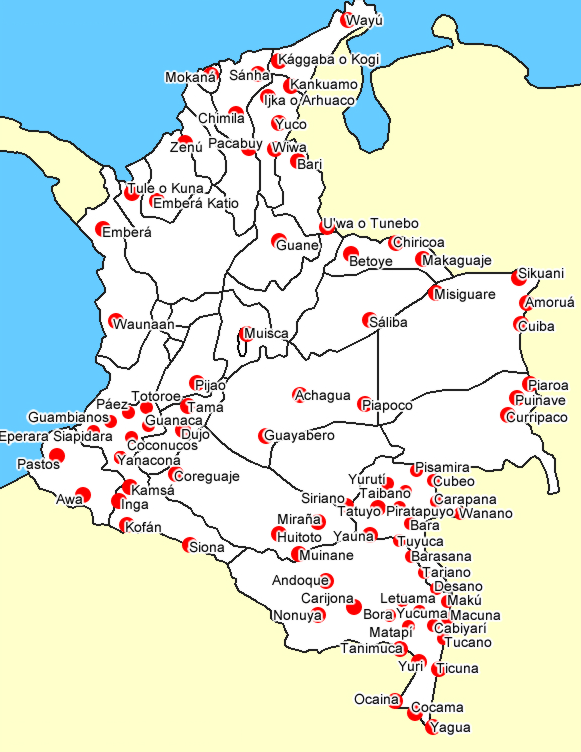
Visa requirement
US, Canada and most Latin American and Europe citizens can enter Colombia for up to 90 days as a visitor with no visa, this will be at the discretion of the Colombian immigration Officer upon arrival. Some Latin American, Asian, African, and Eastern European countries need a visa, which may be arranged from their home countries.
Upon arrival you may need to provide evidence of return or forward travel. As a visitor you can’t remain in Colombia for more than 180 days in any 12 month period.
If you enter Colombia by land from Ecuador or Venezuela, make sure your passport gets stamped by the immigration authorities. Failure to do so may result in a fine on departure.
Culture
Colorful crafts, archaeological sites, paintings, sculptures, festivals and carnivals are visible manifestations of the Colombian people. Their joyous and lively music play a leading role in their heritage.
There is a strong influence from Spanish culture with African and Indigenous elements represented as folk tales and stories about legendary creatures, for example; which are transmitted orally and kept for next generations to come. Some of them are common with other Latin American countries.
Music
Home of famous artists, there’s nothing like the rhythm of the Colombian people, especially in the Caribbean and Pacific coastal regions. The music is on their blood! It’s a mixture of African, native Indigenous, and European influences, as well as more modern American and Caribbean music forms. The music varies greatly between regions.
Some examples are:
Cumbia
This rhythm, fundamental to the Atlantic coast, is the most representative of Colombia in the world. It is played with bagpipes, drums, maracas and a guacharaca (a percussion instrument).
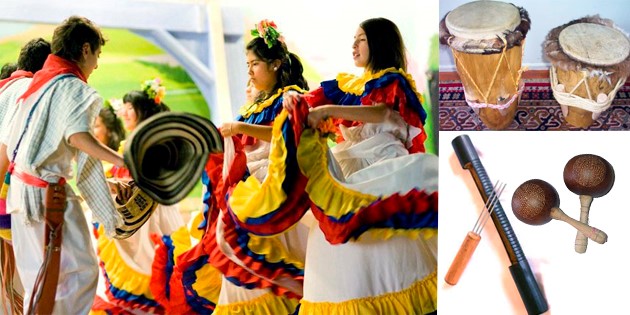
Salsa
Originated in Cuba, this rhythm entered the country through Barranquilla and was popularized in the late 1960’s when Puerto Rican musicians performed in the Cali Fair, a city considered the Salsa's "World Capital”.

Vallenato
The Colombian Caribbean rhythm is named after the site where it was born: the “Upar Valley”. It is played with an accordion box and guacharaca. Rafael Escalona and Alejo Durán are among its great composers.
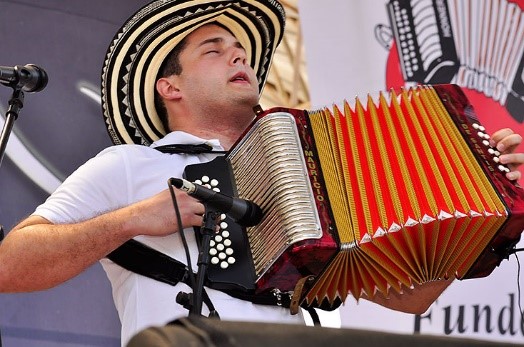
Festivals & Carnivals
Crab Festival (January) in San Andres Islands
On January 1st, the Crab Festival is a good excuse for locals and visitors to head to the island of San Andrés in the Colombian Caribbean to taste delicious crab dishes. Dancing and lively music are also part of the event.

Blacks and Whites Carnival (January) in Pasto
Locals paint their faces black one day and white the next. These are the two main days of the Carnival of Blacks and Whites, which since 2009 is part of UNESCO’s World Cultural Heritage. The celebrations are famous for giant figures made by local artisans walking through the streets of the city.

Cartagena’s Classical Music Festival (January) in Cartagena
The hill of La Popa, the castle of San Felipe, the Adolfo Mejia Theatre, and the Gethsemane auditorium are some of the venues where the musical works of the most renowned composers in history are performed for residents and visitors of Cartagena (nicknamed “La Heroica”) every January, during the Cartagena International Music Festival, invited artists give concerts and talks throughout the duration of the festival.

Barranquilla Carnival (February) in Barranquilla
The Barranquilla Carnival, held in the first quarter of every year, a few days before Ash Wednesday, is the best party in Colombia. The pre-carnival starts in mid-January with a series of street celebrations including dances, processions, and parades. The festivities attract about 500 folk groups, international artists, and just about everyone in Barranquilla. During the Carnival, which UNESCO declared a World Cultural Heritage Event in 2003, attendees revel in the city’s streets to the rhythms of cumbia and mapalé. Since 1903, the Battle of the Flowers parade has included characters such as the Momo Carnival King, María Moñitos, and the Cayman man.

Iberoamerican Theater Festival (March) in Bogotá
Every two years, for 17 days that coincide with Holy Week and Easter, the capital of Colombia becomes an enormous stage thanks to the Iberoamerican Theater Festival of Bogota, one of the largest performing arts festivals in the world. Parades and other free entertainment take over the streets. Theater companies from all five continents participate in the festival.

Rio de Oro Carnival (March) in Río de Oro
Every year in March, the city of Rio de Oro holds a Carnival, a tradition that originated between the 1920s and 30s as a legacy of the people who settled in the shores of the Caribbean. The festivities include floats created by artisans, parades, and a beauty pageant.

Vallenato Legend Festival (April) in Valledupar
The best composers and performers of vallenato music, which includes merengue, puya, paseo, and son meet at the Vallenato Legend Festival, the greatest popular folk culture festival in Colombia. Musicians from countries like Cuba, Aruba, Mexico, Venezuela, and the United States participate in the festival, which began in 1968 and is held every year in late April in Valledupar.

Colombian Folklore Festival (June) in Ibagué, Tolima
One of the most important festivals. During this event, which highlights popular customs through dance, concerts, folk music workshops and shows are held in parks, auditoriums, theaters, museums, and universities. The International Folklore Beauty Pageant is also held during this festival.

ColombiaModa (July) in Medellin
Latin American fashion and clothing designs featured in Colombiamoda in Medellin, an event held annually in July by leading clothing companies. Business conferences, forums, seminars and exhibitions of Colombian and international designers’ fashions are held during this festival.

A Flower Festival (August) in Medellín
Early August of each year Medellín dresses up in colours for the Flower Festival. This celebration was born in 1957 and has events like the Festival of Orchestras. The climax of the event is the Silleteros (saddler’s) parade, where flower farmers design beautiful arrangements which are carried on their backs. Each saddle, which can weigh up to 70 kilos and measure 5 meters in diameter is made of up to 25 different varieties of flowers.

Colombian National Pasillo Festival (August) in Aguadas
Tiple, guitar, and mandolin sound with intensity every year in mid-August, during the National Pasillo Festival. This event, which was held for the first time in 1990, pays tribute to a rhythm that blends the European waltz with popular regional tunes. The program includes competitions for composers and performers, among other categories.

Popayan National Gastronomy Congress (September) in Popayan
An exquisite culinary destination in Colombia. Every September, the city presents new flavors that are the product of rigorous academic research at the National Gastronomic Congress of Popayán. During this event, conferences, educational workshops, and meetings between schools and culinary academies are held, and of course, delicious food samples are offered to all.

World Salsa Festival (September) in Cali
It’s an event not to be missed. Famous bands and about 5,000 dancers from all of the salsa dance schools in the city join dance academies from other cities and abroad. Talks and meetings for music lovers and collectors are also held during the festival.

ArtBo (October) in Bogotá
This is the International Arts Festival of Bogotá. This event, which attracts national and international galleries, is very important for Latin American art. The program also includes cultural and academic events.

International Festival of Amazonian Popular Music: El Pirarucú De Oro (November)in Amazons
Inaugurated in 1987, the International Festival of Amazonian Popular Music is an event held every November, in which music, culture, and traditions of the Amazon all converge. It is the most important celebration of Amazonian popular music and it rescues and reaffirms the values, customs, and traditions of the people of Colombia, Brazil, and Peru.

National Symbols
Colombian National Symbols are the representative elements of the country, and include besides the National Emblem, Anthem and Flag, others like:
The Andean Condor
As the National Bird. It’s the world's largest flying bird and an emblem of freedom and sovereignty since 1834. This bird inhabits the Andean region and it is characterized by its size and scope. An exotic bird that represents the spiritual harmony of those who love their nation!

Colombian Coffee
Famous across the globe for its high quality, Colombian coffee is known for its smoothness and exquisite aroma.

The Wax Palm Tree
As the National Tree. The Ceroxylon quindiuense grows up to 70 feet in the Cocora Valley (Quindío) making it the tallest in the world.

The Orchid
As the National Flower. Native to temperate climates, the “Cattleya trianae” has been a national flower since 1936

Climate
Colombia is privileged in having many climate zones, from warm to freezing areas making the country a perfect destination with a wide variety of landscapes. You can see different wildlife and ecosystems by travelling short distances over land.
Warm
This characteristic warm, sunny weather encourages travelers to enjoy activities such as whale watching in the Pacific; admiring the pink dolphins
With an average temperature above 24 ° C the sunny beaches of San Andres and Santa Marta are places perfect for diving. This tropical climate is also characteristic of the Orinoco plains and parts of western Antioquia where mangos, papayas and other fruit are cultivated.

Temperate or Medium
10% of the country presents destinations with this temperate climate like San Gil in Santander with adventure activities including caving, rafting and rappelling that abound.

Cold
The cold climate makes it possible to observe many species of birds, including the Cauca peahen and the crested eagle. With an average temperature ranging from 12°C to 17°C it’s characteristic of high mountain areas ranging from 2,000 to 3,000 m. Travelers to cold weather sites such as the Corota Island Fauna and Flora Sanctuary can see sparrows, blackbirds and wrens, among other birds.

Moor
White-tailed deer, rock cockerels, condors, anteaters and spectacular bears inhabit wilderness areas of moorland, located between 3,000 and 4,000 m. At this height the average temperature ranges between 6°and 12°C, and is typical on mountaintops, with freezing winds, low rainfall and frequent snowfall. Chingaza National Park presents this type of climate and is a place where visitors come to hike, camp and watch the wildlife.

Glacial
At this point it is difficult to breathe, but some travelers rest their eyes on views of snowy landscapes and walking trails where rivers are born from melting snow, flowing into the Magdalena and Cauca valleys.
In places like Los Nevados National Park and Cocuy National Park where the temperature is below 6 ° C, visitors walk alongside pristine lakes, watching condors and eagles and tackling the challenges of scaling icy walls and rock formations.

Tropical Rainforest
The heat and humidity are characteristic of the tropical rainforest climate. This is the environment that greets visitors to these areas of heavy rains like the jungles of Catatumbo in Chocó, the forests of the Amazon, the central region of Magdalena, the Pacific coast and the eastern slopes of the Eastern Cordillera.

Tropical Steppe
Characterized by high temperatures and is present in areas with little vegetation and minimal rainfall. These are the conditions that greet travelers who visit the savannahs of Bolivar and northern La Guajira; the central area of Llano (Meta and Guaviare rivers); highlands and ridges bordered by mountains.

Tropical Desert
This climate is typical of the least rainy part of the country, with seven months of drought per year. These difficult conditions are part of daily life in the upper Guajira, the northernmost region of Colombia. However, the contrast between the Caribbean Sea and the desert area makes this region very attractive because of the scenery. Pink flamingos bound in places like Punta Gallinas where visitors can enjoy lobster and other seafood.

Currency
Colombia’s oficial currency is the “Colombian Peso”. They come in increments of $1,000, $ 2,000, $ 5,000, $ 10,000, $ 20,000 and $50.00 bills and coins of $50 $ 100, $200, $ 500 and $ 1,000.
When needing to exchange money, it is always advised to do it at exchange houses at airports, hotels and banks. Never in the street.
Travelers bringing more than $10,000 or its equivalent in other currencies, including Colombian pesos in cash must declare it when arriving. If it’s not declared authorities may retain the currency and impose fines.
Most of the cities have ATMs on major roads and shopping centers which mostly operate 24 hour. Please do not give your card or reveal your password to strangers.
Health
The most common illnesses in Colombia are altitude sickness, stomach problems, and malaria and yellow fever in jungle areas.
Vaccination
Visitors must be vaccinated against yellow fever at least 15 days before arrival to the country. The vaccine is not suitable for people with HIV, pregnant women and children under 6 months of age. To visit national parks or wilderness areas other vaccines such as tetanus and hepatitis A and B are also recommended. Visitors from countries offering a Dengue or Zika vaccine should have it applied before traveling if visiting sites below 1,800 m.
Water Consumption
Tap water is safe to drink and use for cooking in Bogotá. Other cities have very good water supply services. However, in rural areas and small towns it is advised to buy bottled water.
Medical Care and Medicine Purchase
Medication and prescription drugs can be obtained without restriction in pharmacies. It’s always recommended to buy a travel insurance that provides international medical and emergency hospital care coverage.
Public Safety and Personal Security Concerns
Even though there have been dramatic improvements in the security situation in Colombia during the last decades, you should always exercise a high degree of caution when visiting it just as any other country you are not from, you are responsible for your personal safety abroad.
It’s always recommended to do research on the places that will be visited. How to get to them, travel on them and how to get away from them. Investigate and understand the destination and its routes.
The presence of armed drug traffickers, guerrilla groups—including the Revolutionary Armed Forces of Colombia and the National Liberation Army (ELN)—and other armed groups pose a major risk to travelers, especially in rural areas. These groups continue to perpetrate attacks, extortion, kidnappings, car bombings and damage to infrastructure. Landmines continue to be used by guerrilla groups.
If you intend to travel to remote areas for eco-tourism or to visit archaeological sites, you should do so only with an experienced and reputable tour guide.
Stay vigilant and be aware of your surroundings at all times when travelling in larger cities, such as Bogotá, Medellín and Cali. Muggings and assaults occur even in safer parts of these cities, and some neighborhoods should be avoided at all times due to high crime rates. Check with your hotel or other reliable contacts in the city you are visiting to determine which areas should be avoided.
Avoid going to bars alone. Never leave food or drinks unattended or in the care of strangers. Be wary of accepting snacks, beverages, gum or cigarettes from new acquaintances, as they may contain drugs that could put you at risk of sexual assault and robbery.
Electricity
Colombia’s electrical system is 110 volts. Three hole grounded plugs are very uncommon, so if you have equipment that needs this type of plug, be sure to bring an adapter or buy one at a hardware store.
Postal System
Fedex, DHL and other courier services are available in major cities of Colombia. Never send cash or anything valuable by regular mail.
Telecomunications
In Colombia, this industry has not stopped growing, as a result of technological progress there has been a greater number of operators expanding their service offerings to meet customer demands. So you may either use the phone at your hotel room to make local or international phone calls or you may also purchase a very inexpensive cell phone or sim card for your own mobile if you pretend to stay longer.
Colombia has many different climate zones, so it’s always better to combine your summer and winter clothing in your bag. It is useful to bring layers of clothing so you can put over and pull out quickly when needed. Bring sunblock, bug spray, flashlight, and waterproof bag, hiking shoes, sunglasses, raincoat and sandals.
Be prepared for rain as well, try to bring light weight, fast drying clothing.
If possible try to fit everything into one carry-on and one checked bag so it will be easier when moving inside the country.

Colombia is located in the northwestern corner of Latin America and bordered by the majestic Andean mountains. It’s home of a highly diverse wildlife due to the country’s varied terrain, making it a crucial hot spot for numerous habitats and extensive biodiversity.
Some of the wildlife visitors to Colombia commonly see:
The Pacarana
Resembling an oversized guinea pig and classed as the third largest rodent in the world.
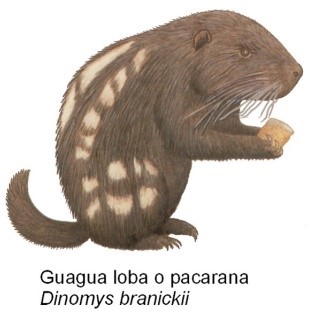
The Red Howler Monkey
It’s renowned for its noisy howls when negotiating territorial space with other males.
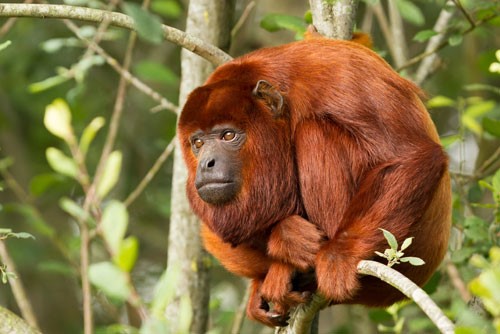
Geoldi's Marmoset
A small creature that is native to the upper Amazon Basin regions. A new world monkey usually black or dark-brown in color, with occasional red, white, or silver highlights on the head and tail.
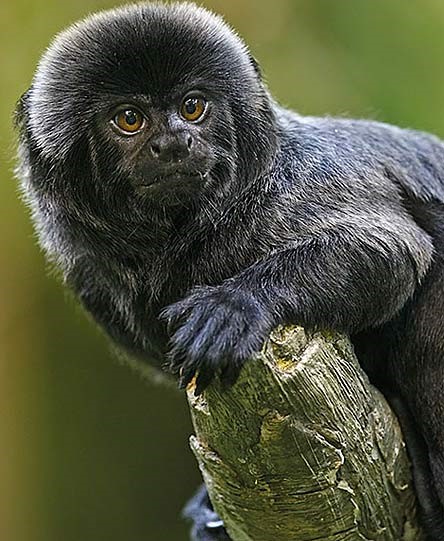
The Andean Condor
It is a large black vulture with a ruff of white feathers surrounding the base of the neck and especially in the male, large white patches on the wings. The head and neck are nearly featherless, and are a dull red color, which may flush and therefore change color in response to the bird's emotional state.
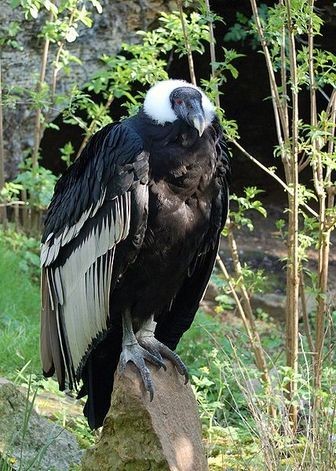
The Blue and Gold Macaw
One of the most beautiful large parrots. They inhabit forest and woodland of tropical Colombia and South America. They are popular because of their striking color, ability to talk, ready and close bonding to humans.
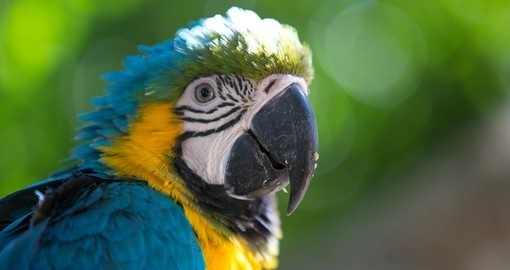
The Pink River Dolphin
Pink dolphins inhabit the Amazon River, but they can also be found in the Orinoco basins and the upper Madeira River as well. While they are mostly pink, these dolphins have various colored skins, which can be light gray, pink, or brown.
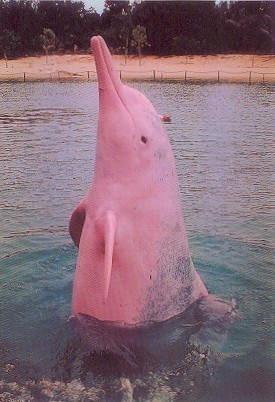
A brief History of Colombia
The history of Colombia is divided into 4 periods: Pre-Columbian, Hispanic, Republican and Modern Periods.
Pre-Columbian Period
It happens about 20,000 years ago when the first inhabitants arrived. They penetrated the Caribbean coast coming from the east. From there, many groups slowly moved into the area and occupied the Andean mountain range. Some groups passed from nomadism to a sedentary lifestyle.
Hispanic Period
It begins with Christopher Columbus arrival to the Americas in 1492 when there were many pre-Columbian cultures and ends in 1810 when the independence process started. This period lasted more than 3 centuries divided into 3 stages:
- The Discovery: It begins with the Spaniard Christopher Columbus arrival and the first time encounter between Spaniards and indigenous people. At this stage, the Spaniards explored new territories, finding rich mineral and forest resources.
- The Conquest: During this time the Spaniards plundered the Indigenous tribes from their lands and possessions subjecting them to slavery. At this stage the first cities were founded.
- The Colony: During this stage Spain consolidates its power in the Americas territories. Due to a decrease of indigenous population, they brought black people from the African continent to work as slaves since they were much stronger. Consequently, there was a huge miscegenation between indigenous, white and black people. The economy at that time was based on gold and silver extraction as well as indigo cultivation.
Republican Period
This period was in the ninth century and it was a time of big confrontations and changes in the country. It started out with the independence in 1810 and culminated with the Boyacá Battle in 1819 led by Simon Bolivar popularly known as the Americas Liberator.
In 1821, delegates of the New Granada (today Colombia, Venezuela and Panama) had a meeting in Cúcuta in order to create a federal state which was named as the Great Colombia. At this time, a new law consisting of the freedom of children born from slaves was introduced. Later in 1830 Simon Bolivar died.
The remaining century time there were more clashes in the country that led to many civil conflicts. In 1903 Panama separated from Colombia instigated by the US political interests in the Panama Canal.
Modern Period
The XX century was inaugurated in Colombia with a war called “Mil Días”; certainly the most remarkable event at that time with the murder of liberal leader Jorge Eliecer Gaitan that occurred on April 9, 1948. This brought the country into an unusual violence that particularly affected the peasants. Subsequently, strengthening drug mafias from the 70’s jeopardized the Colombian society and profoundly affected the ruling classes.
Later on, the government of President César Gaviria (1990-1994) carried out a process he called "Economic Openness" which allowed Colombia to become a globalized economy. During his governance, a new Constitution Letter was signed as well.
The government of President Andres Pastrana (1998-2002) had the closest advancements in regards to dialoguing with the guerrilla armed forces. The actions of paramilitary groups in Colombia and their battles against the guerrilla armed forces created a humanitarian crisis of global proportions that listed the country as one of the most dangerous, with most displaced people, war crimes, massacres and terror in numerous regions of the country.
Álvaro Uribe's government (2002-2010) has been the center of heated debates inside and outside of the country: for many observers, he has brought the peace and security back to Colombia by increasing the credibility to institutions like the police and the army. Still, for others, it has generated corruption scandals in institutions and increase in the violation of human rights by armed groups.
But above all, Colombia shows itself as a country with an undeniable material progress, with a healthier, more diversified economy than its neighbors and the ability to achieve subtle balance in difficult crisis.
Colombian Cuisine is very diverse and varies depending on the different regions. Common diets include a lot of meat, a good variety of fish, lobster and seafood, fresh fruit and many others you have probably never heard of before.
Breakfast is very important in Colombia and consists of fruit juice, coffee or hot chocolate, fruit, eggs and bread. Lunch is the main meal of the day and generally consists of a soup, a main dish, a drink and sometimes a dessert which is usually very sweet. The dinner is normally more like a snack.
Here’s a list of some typical favorites you shouldn’t miss during a trip to Colombia:
Ajiaco
Chicken soup, two kinds of potatoes, corn, sour cream, capers, avocado and guasca leaves.

Arepa
Used as a side to any meal. It is a bread made from cornmeal, similar to a pancake but salty.

Bandeja Paisa
This is a mixture of food on a big plate, made of grilled steak, fried pork rind and chorizo sausages on a bed of rice and red beans that is then topped with a fried egg and a side of sliced avocado and sweet banana chips.

Buñuelos
These are ball-shaped fritters and eaten as a snack. They are made with dough and cheese curd that get fried until golden brown.

Changua
A creamy soup made with milk, water, eggs, and scallions. The eggs are dropped into the mixture without breaking the yolks. It is served with cilantro and a piece of bread that soaks in the mixture.

Empanadas
A stuffed fried pastry that can either be sweet or savory. The savory ones are filled with beef, chicken and/or cheese, rice and coriander.

Fritanga
This is a plate full of grilled meat like beef, chicken, ribs and sausages and fried cow intestines which get served with little potatoes and arepas.

Patacones
These are squashed green plantains that are deep fried in vegetable oil until golden brown.

Colombia is one of the richest countries in the world in biological and cultural diversity. This diversity is represented in 59 natural areas that belong to the National Parks System representing 14'268.224 hectares of the national area (marine and terrestrial).
Here is a list of the best Colombian National Parks that you may visit as well as a map with the general distribution:
- Amacayacu
- Cahuinarí
- Catatumbo Barí
- Chingaza
- Serranía de Chiribiquete
- Cocuy
- Corales del Rosario
- Cordillera de Los Picachos
- El Tuparro
- Farallones de Cali
- Gorgona
- Cueva de los Guácharos
- Los Katíos
- Sierra de La Macarena
- La Paya
- Las Hermosas
- Las Orquídeas
- Los Nevados
- Macuira
- Munchique
- Nevado del Huila
- Old Providence
- Paramillo
- Pisba
- Puracé
- Rïo Puré
- Sanquianga
- Selva de Florencia
- Serranía de los Yariguíes
- Sierra Nevada de Santa Marta
- Sumapaz
- Tamá
- Tatamá
- Tayrona
- Tinigua
- Utría
- Indi Wasi
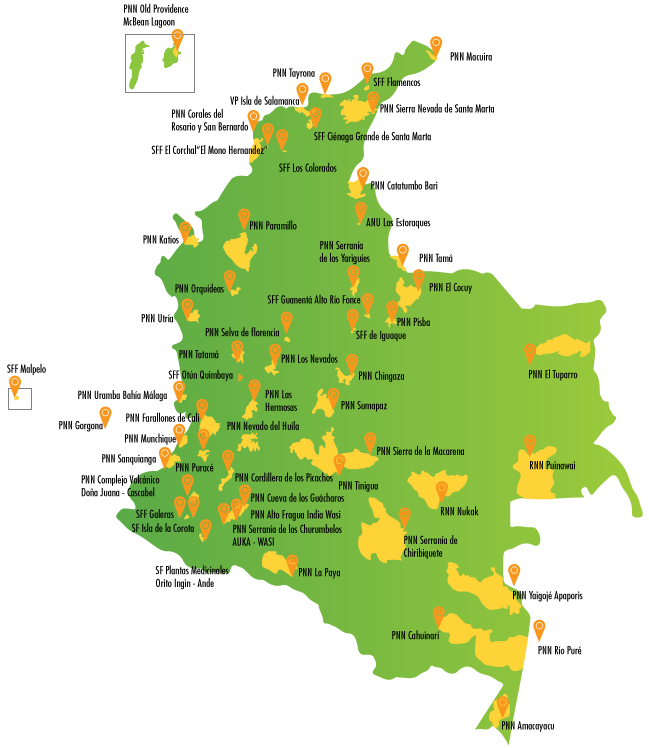
Name: Colombia.
Location: South America, south of Panama and Venezuela, and North of Ecuador, Peru and Brazil.
Capital: Bogota.
Area: 1 141 748 squared km.
Official Language: Spanish.
Population: 48 481 028 (as of 2016).
Ethnic divisions: White (including mestizo) 86%, Black 10.6 %, Indigenous 3.4%.
Religions: Roman Catholic is the official 79%. Protestantism 13%, and others 8%.
Language: Spanish (official), English spoken in some places like San Andres, Providencia and Santa Catalina.
Administrative division: Conformed by thirty-two departments and a Capital District. Each department has a Governor and a Department Assembly, elected by popular vote for a four-year period.
Legal system: Based on the 1991 Constitutional Law. A democratic Republic divided in Legislative, Executive and Judicial Powers.
Education: Include nursery school, elementary school, high school, technical instruction and university education.
Economic main industries: Textiles, Food processing, Oil, Clothing and Footwear, Beverages, Chemicals, Cement; Gold, Coal, Emeralds, Shipbuilding and Electronics Industry.
There are approximately 87 different indigenous groups in Colombia, 18 of them in danger of extinction. The total indigenous population is estimated to be at 1,378,884 people, of which 933 800 are based on the existing 710 safeguards. Many of them still speak their native dialects.

Indigenous Groups Map
This is a distribution map of the indigenous groups located throughout the territory:
